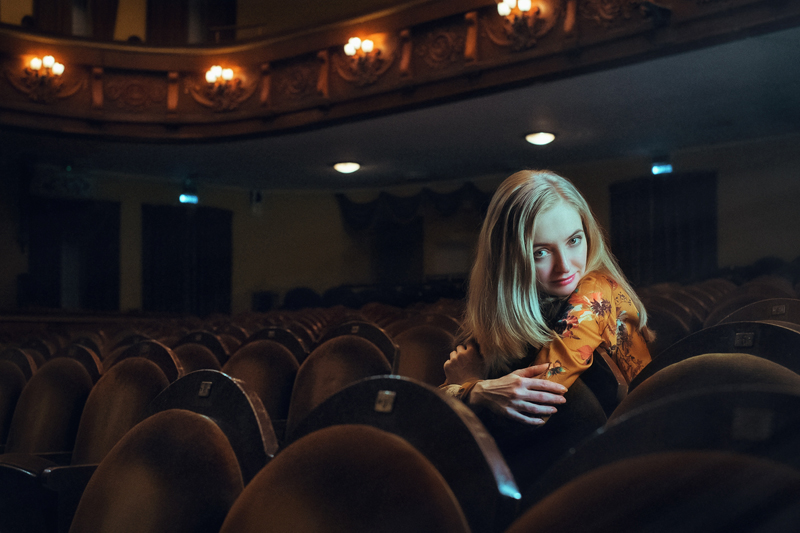Haunted Screens - German Expressionism in Film

There are no works by Edvard Munch or Vincent van Gogh featured in the “Haunted Screens” exhibit celebrating German Expressionist film, but the influence these painters had on the visual style of early film is palpable. Munch’s “The Scream”, with its undulating figure radiating psychological torment, must have been a source of inspiration. The set design drawings by Walter Rohrig for “The Chronicles of the Gray House” (1925) echo Munch’s use of malleable forms and thick, rolling lines to indicate movement and uncertainty.
German Expressionism began to simmer and boil as early as 1913 with “The Student of Prague” (the exhibit features a striking original poster for the film). The 1920s, however, was the decade when Expressionism ignited and filmmakers produced most of their masterpieces. Germany was reeling from its defeat in WWI and the crippling financial reparations required as part of the armistice. The societal unease, the massive disparity between rich and poor, the cynicism and corruption, were reflected in the films of directors Fritz Lang, F.W. Murnau, G.W. Pabst, and Josef von Sternberg. Physical reality was manipulated to reflect mood and emotion. The distorted perspectives, chiaroscuro lighting, and skewed angles were visual manifestations of a character’s mental anguish.
The majority of the material in “Haunted Screens” is on loan from La Cinematheque francaise, and was gathered by its chief archivist Lotte Eisner in the 1950s. Eisner was a German Jew who, although she was interned in France during WWII, chose to stay in Paris for the remainder of her life. As a critic, Eisner championed the work of Lang and Murnau. Her seminal book, “The Haunted Screen: Expressionism in the German Cinema and the Influence of Max Reinhardt”, provided the exhibition’s title. Eisner’s words are also quoted on the museum labels next to the artwork.
The opulent visual imagery of Expressionism was loaded with metaphorical meaning. This is illustrated by one section of the exhibit simply titled “Stairs”. The staircase was used by filmmakers to symbolize tyranny, madness, redemption, sexual vice, flight, death, or justice. Film clips projected on a large screen revealed the profusion of stairs in Expressionist films. Silent film, with its lack of dialogue, was the perfect vehicle for the visual artistry of Expressionism. Murnau’s “The Last Laugh” (1924) is one of the few silent films that told a narrative strictly through images, and used virtually no words.
Although films like Lang’s “Metropolis” (1927) and Wiene’s “The Cabinet of Dr. Caligari” (1920) are celebrated (rightly so) for their visionary set design, it is the human faces in Expressionist films that I find unforgettable. Emil Jannings as the hotel doorman reduced to a bathroom attendant in “The Last Laugh”, or Peter Lorre as the haunted child murderer in “M” (1930) are the evocative representations of a disintegrating society that would soon succumb to fascism and the horrors of WWII.
The Milwaukee Art Museum presented the “Haunted Screens” exhibit, which I attended at my own expense.
Article posted on 1/21/2017.
German Expressionism began to simmer and boil as early as 1913 with “The Student of Prague” (the exhibit features a striking original poster for the film). The 1920s, however, was the decade when Expressionism ignited and filmmakers produced most of their masterpieces. Germany was reeling from its defeat in WWI and the crippling financial reparations required as part of the armistice. The societal unease, the massive disparity between rich and poor, the cynicism and corruption, were reflected in the films of directors Fritz Lang, F.W. Murnau, G.W. Pabst, and Josef von Sternberg. Physical reality was manipulated to reflect mood and emotion. The distorted perspectives, chiaroscuro lighting, and skewed angles were visual manifestations of a character’s mental anguish.
The majority of the material in “Haunted Screens” is on loan from La Cinematheque francaise, and was gathered by its chief archivist Lotte Eisner in the 1950s. Eisner was a German Jew who, although she was interned in France during WWII, chose to stay in Paris for the remainder of her life. As a critic, Eisner championed the work of Lang and Murnau. Her seminal book, “The Haunted Screen: Expressionism in the German Cinema and the Influence of Max Reinhardt”, provided the exhibition’s title. Eisner’s words are also quoted on the museum labels next to the artwork.
The opulent visual imagery of Expressionism was loaded with metaphorical meaning. This is illustrated by one section of the exhibit simply titled “Stairs”. The staircase was used by filmmakers to symbolize tyranny, madness, redemption, sexual vice, flight, death, or justice. Film clips projected on a large screen revealed the profusion of stairs in Expressionist films. Silent film, with its lack of dialogue, was the perfect vehicle for the visual artistry of Expressionism. Murnau’s “The Last Laugh” (1924) is one of the few silent films that told a narrative strictly through images, and used virtually no words.
Although films like Lang’s “Metropolis” (1927) and Wiene’s “The Cabinet of Dr. Caligari” (1920) are celebrated (rightly so) for their visionary set design, it is the human faces in Expressionist films that I find unforgettable. Emil Jannings as the hotel doorman reduced to a bathroom attendant in “The Last Laugh”, or Peter Lorre as the haunted child murderer in “M” (1930) are the evocative representations of a disintegrating society that would soon succumb to fascism and the horrors of WWII.
The Milwaukee Art Museum presented the “Haunted Screens” exhibit, which I attended at my own expense.
Article posted on 1/21/2017.
You Should Also Read:
Ida Lupino - Two Films

Related Articles
Editor's Picks Articles
Top Ten Articles
Previous Features
Site Map
Content copyright © 2023 by Angela K. Peterson. All rights reserved.
This content was written by Angela K. Peterson. If you wish to use this content in any manner, you need written permission. Contact Angela K. Peterson for details.


